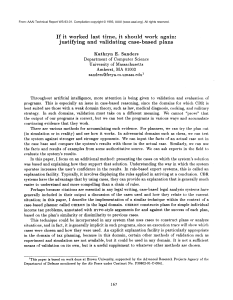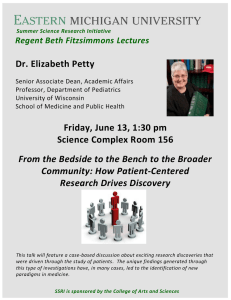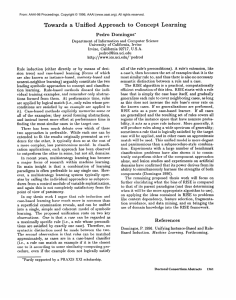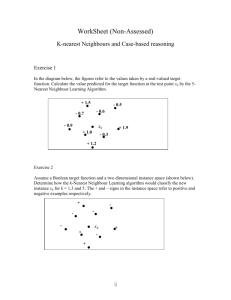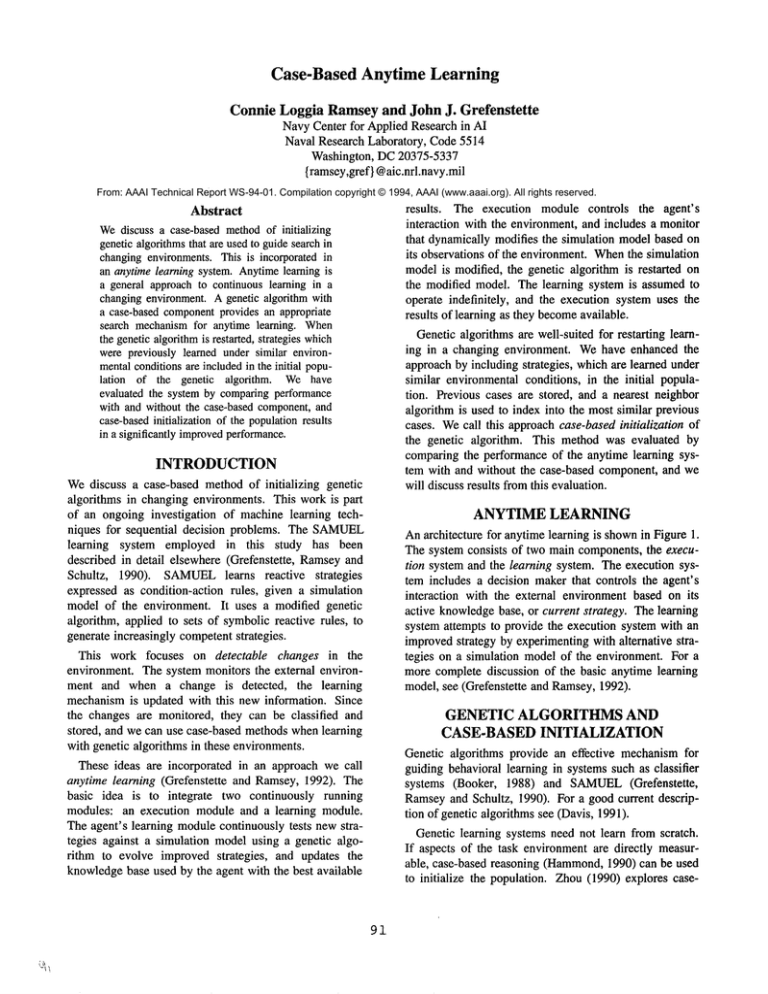
Case-Based Anytime Learning
Connie Loggia Ramsey and John J. Grefenstette
Navy Center for Applied Research in AI
Naval Research Laboratory, Code 5514
Washington, DC20375-5337
{ ramsey,gref}@aic.nrl.navy.mil
From: AAAI Technical Report WS-94-01. Compilation copyright © 1994, AAAI (www.aaai.org). All rights reserved.
Abstract
Wediscuss a case-based methodof initializing
geneticalgorithmsthat are usedto guidesearch in
changingenvironments.This is incorporated in
an anytimelearning system. Anytimelearning is
a general approach to continuous learning in a
changingenvironment.A genetic algorithm with
a case-based componentprovides an appropriate
search mechanismfor anytime learning. When
the geneticalgorithmis restarted, strategies which
were previously learned under similar environmentalconditionsare includedin the initial population of the genetic algorithm. Wehave
evaluated the system by comparingperformance
with and without the case-based component,and
case-basedinitialization of the populationresults
in a significantly improvedperformance.
INTRODUCTION
Wediscuss a case-based method of initializing genetic
algorithms in changing environments. This work is part
of an ongoing investigation of machine learning techniques for sequential decision problems. The SAMUEL
learning system employed in this study has been
described in detail elsewhere (Grefenstette, Ramseyand
Schultz, 1990). SAMUEL
learns reactive strategies
expressed as condition-action rules, given a simulation
model of the environment. It uses a modified genetic
algorithm, applied to sets of symbolic reactive rules, to
generate increasingly competentstrategies.
This work focuses on detectable changes in the
environment. The system monitors the external environment and when a change is detected, the learning
mechanismis updated with this new information. Since
the changes are monitored, they can be classified and
stored, and we can use case-based methodswhen learning
with genetic algorithms in these environments.
results. The execution module controls the agent’s
interaction with the environment, and includes a monitor
that dynamically modifies the simulation modelbased on
its observations of the environment. Whenthe simulation
modelis modified, the genetic algorithm is restarted on
the modified model. The learning system is assumed to
operate indefinitely, and the execution system uses the
results of learning as they becomeavailable.
Genetic algorithms are well-suited for restarting learning in a changing environment. Wehave enhanced the
approach by including strategies, whichare learned under
similar environmental conditions, in the initial population. Previous cases are stored, and a nearest neighbor
algorithm is used to index into the most similar previous
cases. Wecall this approach case-based initialization of
the genetic algorithm. This method was evaluated by
comparing the performance of the anytime learning system with and without the case-based component, and we
will discuss results from this evaluation.
ANYTIME
LEARNING
Anarchitecture for anytimelearning is shownin Figure 1.
The system consists of two main components, the execution system and the learning system. The execution system includes a decision maker that controls the agent’s
interaction with the external environment based on its
active knowledgebase, or current strategy. The learning
system attempts to provide the execution system with an
improvedstrategy by experimentingwith alternative strategies on a simulation model of the environment. For a
more complete discussion of the basic anytime learning
model, see (Grefenstette and Ramsey,1992).
GENETIC
ALGORITHMS
AND
CASE-BASED
INITIALIZATION
Genetic algorithms provide an effective mechanismfor
guiding behavioral learning in systems such as classifier
systems (Booker, 1988) and SAMUEL
(Grefenstette,
Ramseyand Schultz, 1990). For a good current description of genetic algorithms see (Davis, 1991).
These ideas are incorporated in an approach we call
anytime learning (Grefenstette and Ramsey, 1992). The
basic idea is to integrate two continuously running
modules: an execution module and a learning module.
The agent’s learning modulecontinuously tests newstrategies against a simulation model using a genetic algorithm to evolve improved strategies, and updates the
knowledgebase used by the agent with the best available
Genetic learning systems need not learn from scratch.
If aspects of the task environment are directly measurable, case-based reasoning (Hammond,1990) can be used
to initialize the population. Zhou(1990) explores case-
91
EXECUTION
r----------,
SYSTEM~ Monitor
of time, its last turn, and its bearing, heading, and range
relative to the target. The tracker must learn to control
both its speed and its direction. For further details, see
(Grefenstette and Ramsey,1992).
The anytime learning system uses a competition-based
production system as the execution system and SAMUEL
as the learning system. The system learns a reactive strategy consisting of a set of situation-response rules. In
these studies, the monitor measuresseveral aspects of the
environment:the speed distribution, the turn distribution
(in degrees) and the size of the target agent. The speed
and turn distributions are assumedto be Gaussian distributions, and the size of the target is a discrete integer
representing the current size. The monitor’s task is to
decide howwell the observedspeeds, turns and size of the
target in the external environmentmatchthe current distributions or values assumed in the simulation model of
the SAMUEL
learning system. Using the 50 most recent
samples of the target’s speed and turns, the monitor computes the observed mean and variance of these samples,
and compares the observed values with the current simulation parameters, using the F-test to comparethe variances and the t-test to comparethe means. If either statistical test fails, the monitor changes the simulation
parameters to reflect the newobserved meanand variance
of the target speed or turn. Whena newsize is detected,
the monitor updates this value in the simulation model. A
change in simulation parameters then causes the genetic
algorithmto restart.
LEARNING
SYSTEM
Figure 1: Anytime Learning System
based methodsapplied to classifier systems. He uses past
experience to recall similar cases whenfaced with a new
environment. If no relevant past cases exist, then the
standard classifier systemalgorithm learns a newsolution.
In a different, interesting combination of case-based
methodsand genetic algorithms, Skalak (1993) utilizes
genetic algorithm to identify small, reliable sets of
instances to reduce the number of instances used for
nearest neighbor retrieval. Kelly and Davis (1991) use
genetic algorithm to find a vector of weightings of the
attributes used in a nearest neighbor calculation in order
to reduce the effects of irrelevant or misleadingattributes
and thus to makethe distance measure more meaningful.
Ramand Santamaria (1993) use continuous case-based
reasoning to perform tasks such as autonomousrobotic
navigation. They learn cases which provide information
for the navigation system to deal with specific environments encountered.
Strategies are selected by the learning systemfor use by
the execution system, as follows: The genetic algorithm
in SAMUEL
evaluates each strategy by measuring the
performance of the given strategy when solving tasks on
the simulation model. At periodic intervals a single best
strategy is extracted from the current population to
represent the learning system’s current hypothetical strategy. If the current hypothesis outperforms (in the simulation model) the execution system’s current strategy, the
execution systemaccepts the learning system’s strategy as
its newcurrent strategy.
Our anytime learning system employs genetic algorithms to learn the most effective strategies for each
environmental case encountered. When a change is
detected, the genetic algorithm is restarted with a newinitial population. This work incorporates case-based initialization of the genetic algorithminto the anytimelearning system. As the simulation model changes, we can
develop a history of past cases (of previous environments)
seen, and we can use the best solutions found so far for
previous similar cases to seed the population of new
cases.
Table 1: Population whenResetting the Learning System
BestSolutionsof SimilarCases(50%)
Members
of PreviousPopulation (25%)
DefaultStrategies(12.5%)
ExploratoryStrategies(12.5%)
TASK ENVIRONMENT
AND LEARNING
SYSTEM
The task used in this case study is a two-agent game of
cat-and-mouse in which certain environmental conditions
change over time. The tracker agent (the cat) must learn
to keep the target (mouse) within a certain distance,
called the tracking distance. The target follows a random
course and speed. The tracker agent can detect the speed
and changein direction of the target as well as keep track
Whenthe learning systemreceives a restart notice from
the monitor, it begins a new epoch of learning on its
updated simulation environment by formulating a new
initial population for the genetic algorithm. The initial
populationrepresents the system’s initial set of hypothetical strategies for the new environment. In this study, we
92
verge towardthe appropriate strategies.
seed the initial populationwith four classes of strategies,
as shownin Table 1. One eighth of the population is initialized with default strategies that are knownto perform
moderately well against a broad range of cases. The
default strategies will provide useful starting points for
the learner if the environment is changing from an
extreme special case back to what the simulation designer
considered a more normal case. One eighth of the population is initialized with strategies that generate essentially randombehavior by the tracker (exploratory strategies). These strategies will provide useful starting
points for the genetic algorithm if the environment is
changing in a direction that has not been encountered
before. Next, one quarter of the strategies in the current
population are chosen to survive intact. This provides a
bias in favor of the assumption that the newenvironment
is essentially similar to the previous one. Also, it helps to
guard against the effect of restarting learning whenan
irrelevant parameter has changed. Finally, case-based
initialization is used to seed the other half of the population; it is initialized with the best strategies previously
learned in up to five similar epochs. This group is given
the greatest emphasis because it should provide the most
useful strategies for dealing with the new environment,
once a case history is established. A nearest neighbor calculation is performed to find the five closest matchesto
the current simulation’s set of parameters, as follows:
Each epoch encountered by the system is indexed by its
observed parameters. When a new environment is
encountered, the current parameters are comparedagainst
all previous cases by taking the Euclidean distance of the
current set Enew and each previous set of parameters E
i
as shown:
d(Enew , Ei)
[k~l(
EXPERIMENTS AND RESULTS
The experiments were designed to explore how well the
anytime learning system with case-based initialization of
the genetic algorithm responds to multiple changing
environmental conditions. For this study, we test the
hypothesis:
Dynamically modifying the simulation model
and initializing the population with members
of previous similar states will accelerate
learning in a changing environment.
Our tests involved both relevant and irrelevant parameters. The distributions of the speed and turning rate of the
target are relevant and the size of the target is irrelevant.
Three distinct relevant environmentalstates occur during
each experiment:a baseline state, a high-turn state, and a
high-speed state. The tracking task is muchmoredill]cult
in the high-speedand high-turn states.
PREVIOUS
RESULTS
To test the major componentsof the approach, we previously compared three modes of operation (Ramsey and
Grefenstette, 1993). The first modewas case-based anytime learning, (anytime learning with case-based initialization of the genetic algorithm). The second modewas
anytime learning in whichcase-based initialization is disabled. After each restart,
the new population is
comprisedonly of copies of a default strategy plan, a general plan, and membersof the most recent previous population. The third modewas baseline learning, in which
the monitor was disabled. In this mode,the learning system receives no notification of environmental changes,
and continues to learn on the baseline state simulation for
the entire experiment. However, if the learning system
finds a strategy that tests better on the simulation model,
it passes this to the execution systemfor use against the
environment.
The performance of the case-based anytime learning
system achieves significantly better performancethan the
baseline run. The case-based anytime learning continues
to learn not only within each epoch, but also from one
epoch to the next similar epoch. Furthermore, little time
is lost in bringing the performanceback up to the level of
performance on the previous occurrence of the same
environmental state. For a more complete discussion of
these and other previous results, see (Ramseyand Grefenstette, 1993).
2i,k-Pnew, k)
pn ]1/’2
where n = the number of parameters, and Pi, k = parameter k in Epochi. Weintend to look into algorithms which
will reduce the numberof instances for nearest neighbor
retrieval since this will becomevery costly as the case
history grows. Also, we intend to weight the cases by
howrecent they are, since recent similar cases usually
contain higher performance strategies. In the current
method, the five lowest differences in distance and the
corresponding past case numbers are then used to index
into the best strategies of these five nearest neighbors.
Then the best strategies of these cases are placed in the
newpopulation, and replicated as necessary to fill up half
of the initial population. This restart policy illustrates the
advantage of the population-based approach used by the
genetic algorithm: it allows the learning system to hedge
its bets, since the competitionamongthe strategies in the
population will quickly eliminate the strategies that are
not appropriate for the new environment, and will con-
NEW RESULTS
Our current efforts have focused on assessing the robustness of case-based learning when irrelevant parameters
vary, when much longer runs are performed, and when
93
past cases are similar, but not identical.1
turn and high speed cases, and also by combiningthe high
turn and high speed parameters in someof the epochs (a
We compared a new mode of operation, in which we
combinedstate). The tracking task is muchmoredifficult
varied irrelevant parameters, against the results of the
whenthese conditions are combined.The results, in Figprevious experiment. The experiment begins and ends
ure 4, showthat case-based initialization still allows for
with the baseline state, and the high-turn and high-speed
significantly increased performance whenthere are simistates occur during alternate time periods of 150 episodes.
lar, though not identical, past cases. The high speed
Withineach of these time periods, the size of the target,
epochs
are showingmoresignificance in increased perforan irrelevant parameter, was varied every 50 episodes.
mance
than
the high turn epochs. Weconjecture that the
Figure 2 shows the results of comparingcase-based anylearned
behavior
is moresensitive to the variance in the
time learning in which irrelevant parameters were not
turn
range
we
chose.
Also, there is not muchgain in perchanged during the high-turn and high-speed 150-episode
formance
when
past
cases
are used in combination. For
time periods to case-based anytime learning in which
the
case-based
initialization
runs, the later combinedturn
irrelevant parameters were changed. The main result is
and
speed
epochs
do
have
slightly
increased performance,
that learning is hampered because epochs are much
but
this
seems
to
be
more
due
to
having
seen these combismaller and morefrequent. There is less time for learning
nations
together
previously,
since
the
earlier combined
before unnecessarily restarting the learning process. If
epochs
are
not
performing
any
better.
the irrelevant parameters do not change much, then they
have little effect, but if they do changeoften, then perforA limitation to the case-based anytime learning system
mance can worsen.
is shown in these experiments. If the environment
changes too rapidly due to relevant or irrelevant parameo 100 200 300 400 500 600 700 800 900 1000
ters, then the learning system will not have enoughtime
lOO
lOO to learn against the current simulation, and other methods
Success80
- ~u~
i
I
wouldbe needed to learn in this situation. Also, if the
I
i
I
I . - 80
I
i
i
i
i
i[
Rate 60-environment always changes to very different states and
- 60
Of
has no history of previous similar states, then case-based
Current40-- 40
anytime learning should perform as the original anytime
StrategY20
_
- 20
learning system did. The cost to the system in overhead
¯ .Ip. -Irrele i~tn, Cas~s
’
I
lit
for storing the history of past cases, and doing the nearest
:~
0
o
neighbor calculations is currently negligible. However,
0 100 200 300 400 500 600 700 800 900 1000
this cost will growas the case history increases, and this
Episodes
must be addressed in future work.
The most promising aspect of these results is that,
Figure 2: Case-Based Anytime Learning
within
each of the epochs after an environmentalchange,
vs. Case-BasedAnytimeLearning with Irrelevant Parameters
the case-based anytime learning system generally
improves the performance of the execution system over
In a second experiment, a muchlonger run containing
manymore epochs was performed to assess the robustness
the course of the epoch. Furthermore, through case-based
of the case-based learning componentas the number of
initialization of the genetic algorithm, the learning system
cases increases. There were 30 alternating high turn and
continues to improve on cases it has seen before, and
high speed epochs. The results, in Figure 3, verify that
there is a substantial reductionin the initial cost of a resthe increased performanceusing case-based initialization
tart in learning. The case-based anytime learning system
continues to hold after manyepochs, and the increased
remains robust as the number of cases grows and also
performanceis almost alwaysstatistically significant.
whenprevious cases are similar, but not identical.
’l I" I’l
l" I’l
r j’
In a third experiment, we evaluated the case-based initialization componentby varying the values of the high
SUMMARY
This paper presents a novel combination of two methods
of machine learning (genetic algorithms and case-based
approaches) to perform learning in a changing environment in which we can monitor the changes. Anytime
learning with case-based initialization showsa consistent
improvement over anytime learning without cage-based
initialization.
Case-based initialization automatically
biases the search of the genetic algorithm toward relevant
, Thegraphs were generated as follows: During each run of the system,
the strategy used during each 10-episode block by the execution system was
stored, and later tested on 1000 randomlyselected episodes, using the same
environment that it encountered during the run. Each data point in the
graphs represents the average performance of a strategy over these 1000
episodes. The data is averaged over 10 independent sets of runs for each
experiment. The dashed vertical lines indicate the points at which the
environment changes. A vertical bar between two corresponding points on
the two graphs indicates a statistically significant difference at the 0.95 level
(using a t-tes0.
94
1000
0
1500
2000
2500
3000
3500
4000
100 -
4500
I’
Success80-Rate 60-Of
Current40 -Strategy20_
100
- 80
-- 60
- 40
- 20
Io
0
0
1000
1500
2000
2500
3000
3500
4000
4500
Episodes
Figure 3: Case-Based Anytime Learning vs. Anytime Learning
0
50O
100
Success80Rate 60Of
Current40 Strategy20_
I
I +
-1
0
I
I 0
I
t
I"
I +
I
t
IOO0
!
I
O+ l 0
t
~
i
II
I
I +
L
I
I
[
1500
I
I
I O+ I +
[
I
I
r~
I
I 0
I
I
I
I +
I
r ~n~nt
2OOO
I
I
I O+ I 0
I
I
t
I
t ,~f
I +
t
~
"A°yt’,
’I
0
25OO
I
| 0
I
I
I
I O+ I /
I
: !
500
1000
1500
2000
, ,oo
80
_2o
0
2500
Episodes
Note: + indicates
Figure 4: Case-Based Anytime Learning vs. Anytime Learning
high turn epoch, o indicates high speed epoch and o+ indicates
a combination
CA: Morgan Kaufmann.
areas of the search space. Little time is lost attaining a
similar level of learning as in the previous same cases,
and then improving on that performance.
Grefenstette, J. J., C. L. Ramseyand A. C. Schultz (1990).
Learning sequential decision rules using simulation modelsand
competition. MachineLearning 5(4), 355-381.
The approach presented here assumes that there is a
simulation model available for learning, and that environmental changes can be monitored and accommodated by
changing the simulation parameters. Obviously, the value
of monitoring the environment will be most significant
when the external environment differs from the simulation
designer’s initial assumptions. The method is intended to
be applied to environments with multiple parameters and
possibly infinite cases over very long periods of time. If
the complexity and uncertainty
about the environment
prevents the use of look-up tables, and the environment
changes slowly with respect to the speed of the learning
system, the approach to anytime learning using casebased initialization of genetic algorithms is promising.
Hammond,K. J. (1990). Explaining and Repairing Plans That
Fail. Artificial Intelligence 45, 173-228,
Kelly, J. D. and L. Davis (199l). A Hybrid Genetic Algorithm
for Classification. Proceedingsof the 12th International Joint
Conferenceon Artificial Intelligence (pp 645-650).
Ram, A. and J. C. Santamaria (1993). Continuous Case-Based
Reasoning. Case-Based Reasoning: Papers from the 1993
Workshop, Tech. Report WS-93-01, (pp 86-93). AAAIPress,
Washington, D.C.
Ramsey,C. L and J. J. Grefenstette (1993). Case-BasedInitialization of Genetic Algorithms. Proceedingsof the Fifth International Conferenceon Genetic Algorithms (pp 84-91).
Skalak, D. B. (1993). Using a genetic algorithm to learn prototypes for case retrieval and classification. Case-BasedReasoning: Papers from the 1993 Workshop, Tech. Report WS-93-01
(pp 211-215). AAAIPress.
References
Booker, L. B. (1988). Classifier Systems that Learn Internal
World Models. Machine Learning 3(3), 161-192.
Zhou, H. H. (1990). CSM:A computational model of cumulative learning. MachineLearning 5(4), 383-406.
Davis, L. (1991). L. Davis (editor). The Handbookof Genetic
Algorithms. Van Nostrand Reinhold, N.Y., 1991.
Grefenstette, ]. J. and C. L. Ramsey(1992). An Approach
Anytime Learning. Proceedings of the Ninth International
Conference on Machine Learning, (pp 189-195), San Mateo,
95

